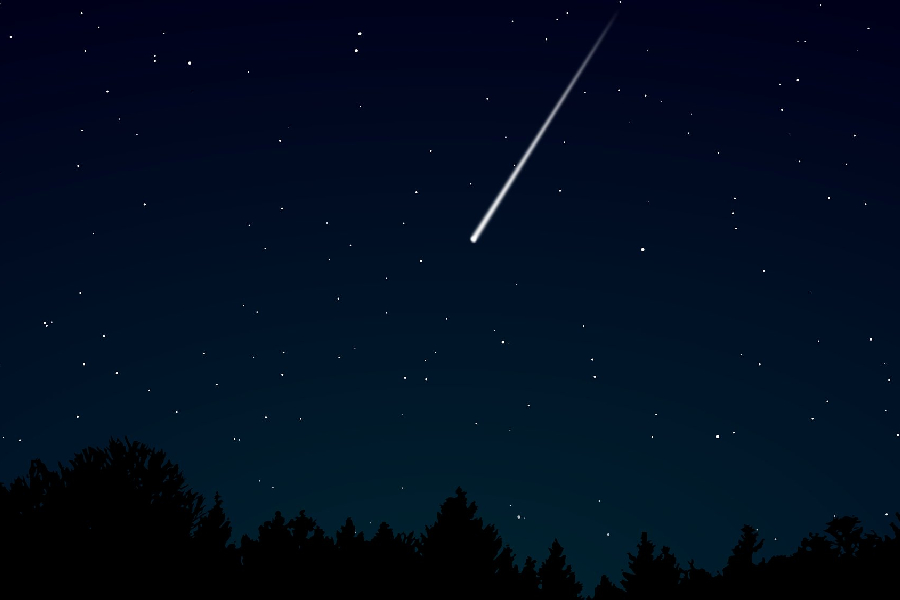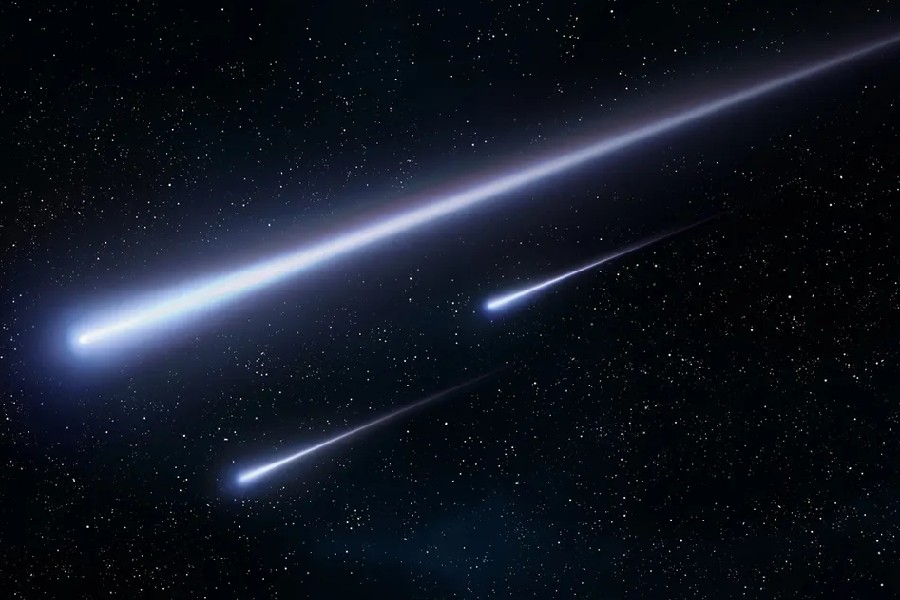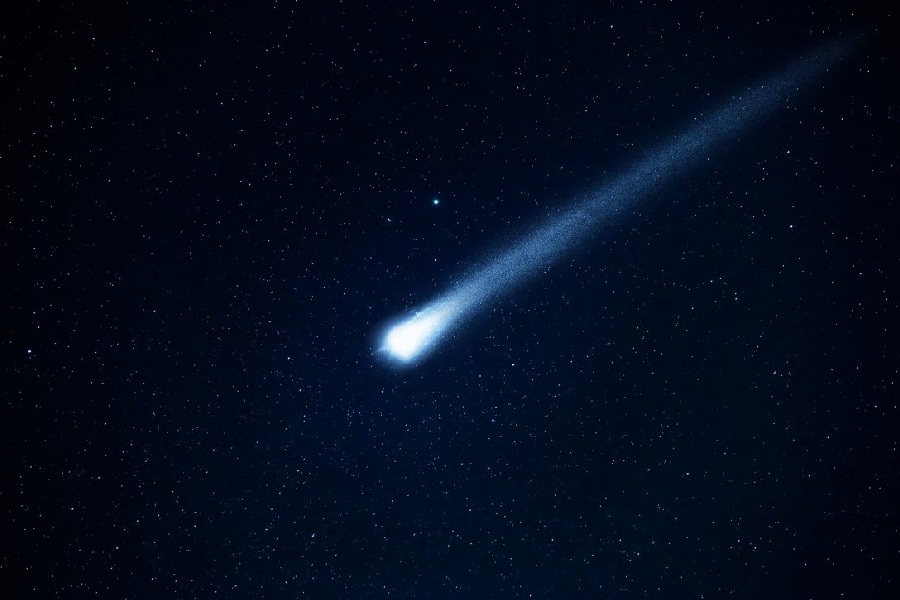On a dark, clear night, keen sky observers may witness bright streaks of light that briefly blaze overhead before vanishing as quickly as they appeared. These shooting stars or meteors demonstrate the perpetual rainfall of debris intersecting Earth’s atmosphere. But what is a meteor? What causes a meteor?
In this article, we will explore meteors in detail and study their high-velocity impacts and constituent materials to better grasp meteor nature. Also, we’ll ponder the implications of destructive airbursts while reveling in meteor showers as sublime celestial celebrations.

What Is a Meteor?
A meteor is a bright streak of light caused by a small space rock or particle called a meteoroid. This happens when it enters the Earth’s atmosphere and starts burning due to friction with air particles.
A meteor only becomes visible high up in the atmosphere when it vaporizes. If part of the meteor survives falling through the atmosphere and lands on Earth’s surface, the remaining piece is called a meteorite.
History of the Term Meteor
Historical context and evolution of the term
The term “Meteor” has evolved over centuries, tracing its roots to ancient Greece. In ancient times, celestial phenomena like shooting stars were attributed to divine entities, with the Greek word “Meteōros” meaning “high in the air” or “lofty.” Aristotle later used “Meteora” to describe atmospheric phenomena, encompassing everything above the Earth’s surface.
During the 19th century, as scientific understanding advanced, the term narrowed its focus to denote the streaks of light produced by meteoroids entering Earth’s atmosphere. This distinguished them from meteors in the broader atmospheric context.
Today, “meteor” refers to the luminous trails created by meteoroids during their fiery passage through the sky.
Where Do Meteors Come From?
Interplanetary dust and debris
Where do meteors come from? Meteoroids originate from leftover debris during the solar system’s formation over 4.5 billion years ago. They also result from collisions between asteroids, comets, and planets, generating interplanetary grit across geological timescales.
Dust grains get stirred up by planetary gravity and pressure from solar radiation, taking up independent orbits around the Sun. This dust gradually spreads across the inner solar system.
Comets and asteroids
Jupiter’s gravity often redirects asteroids into unstable orbits while cometary debris trails planets after flybys. This launches rocks and icy chunks toward terrestrial worlds. So, meteoroids stem from crumbling comets and eroding asteroids injected into collision courses with Earth as they sweep through crowded solar system space.
Meteoroid streams
The trails of dust, ice and fragments left behind by repeating comets and groups of asteroids create meteoroid streams we intersect at predictable parts of our yearly orbit. These dense trails concentrate meteor activity into prolific displays like the Perseids and Leonids as Earth crosses these dust bands and streams head-on at high velocity.
Meteor zone types
Meteors blaze trails according to what zone of the atmosphere they penetrate. Sporadic meteors slam into the upper mesosphere from random trajectories.
On the other hand, shower meteors tear through the ionosphere from meteoroid stream dust bands while fireballs outshine them both, arcing spectacularly across skyscapes.

Types of Meteors
Stony meteorites
Stony meteorites constitute over 90% of witnessed falls and collected specimens. As their descriptive name suggests, they contain high abundances of mineral silicates like olivine and pyroxene mixed with small amounts of metals (iron and nickel alloys).
Furthermore, shapes range from angular fragments to rounded masses during passage through the atmosphere. These originate from protoplanetary crusts and shattered asteroids.
Analyzing the shock deformation features, patterns of crystallization, and well-preserved primordial chondrules offers insight into the violent collisions occurring in the dynamic early asteroid belt. This exploration probes the geological processes shaping celestial bodies during this dynamic period.
Also, tracking the molten histories recorded in stony meteorites supplies incremental evidence for reconstructing metamorphosis scenes, magma ocean solidification, and geothermal activity. These processes, including catastrophic breakups, are integral to asteroid evolution over four billion years.
Iron meteorites
These meteorites, which are nearly exclusively made of iron-nickel alloys, condense molten material that is driven off from asteroid cores by impacts with metallic asteroids or protoplanet explosions. Structures span crystalline octahedrite grouped in Widmanstätten patterns to coarse statute formations.
Rare elements like gallium, germanium and iridium betray their primordial origins. Also, iron meteorites provide a unique glimpse into early planetary differentiation and the complex thermal activity that produced distinct chemical layers in protoplanets.
As time capsules of chaotic epochs predate Earth, their lasting relics expand insights into accelerating spins, churning electromagnetic dynamos, and cooling rates. These factors defined Mars-sized planetesimals that ultimately shattered to form our asteroid zones.
Carbonaceous chondrites
These rare meteorites exhibit incredibly primitive properties, lacking signs of post-accretion alteration effects. This makes them among the most lucid samples of early accretion disc chemistry.
These rare meteorites exhibit incredibly primitive properties, lacking signs of post-accretion alteration effects. This makes them among the most lucid samples of early accretion disc chemistry.
Moreover, dusted with presolar grains that formed around dying stars, carbonaceous chondrites contain materials delivered from across the galaxy. They coalesced locally into stones orbiting nearby young stars like our Sun.
Their extraterrestrial organics inform about conditions favorable for abiogenesis in exoplanetary systems. They also illuminate solar nebula chemistry at the edges of our planet-forming disk.
Composition of Meteors
Asteroidal and cometary sources
Meteors exhibit a range of mineral constituents depending on whether they originate from stony asteroids, icy comets, or metallic asteroids. High metal content and low silicate iron-nickel meteorites most likely originate from the molten cores or mantles of early-forming differentiated protoplanets.
Stony meteorites are rich in silicates, and minerals reflect origins in the broken-apart layers of such planetesimals. Cometary debris and primitive, water-altered carbonaceous chondrite meteorites contain abundant organics, ices, and hydrated silicates.
Probing early solar system origins
Meteorites offer insights into the conditions of the early solar system over 4.5 billion years ago through their textures, layering, chemistry, and raw ingredients. Researchers analyze heat-induced patterns, crystallization trends, chondrules, and grain structures within meteorites to uncover details about the temperatures, shocks, and aqueous alteration experienced by asteroids and comets.
These meteoritic clues depict the violence, melting, and subsequent cooling faced by growing protoplanets in the swirling disc of gas and dust around the young Sun. Each fallen meteoroid reveals new information about planetary differentiation epochs and space chemistry, contributing to the understanding of the formation of inner rocky worlds like Earth and Mars. The brief blaze of a disintegrating meteor holds significant clues about the early solar system’s history, surpassing its quick, flashy demise.

Origin in Asteroid Belt or Interplanetary Space
Asteroid Belt and Kuiper Belt
The Asteroid Belt and scattered disc represent two primary reservoirs producing meteoroids that later blaze as meteors. Located between Mars and Jupiter, the main asteroid belt harbors millions of rocky bodies ranging in size from dwarf planets to tiny fragments.
Likewise, the more diffuse Kuiper Belt and scattered disc contain trillions of icy bodies in irregular orbits. Perturbations from Neptune and Uranus rearrange trajectories, propelling some comets like Halley inwards to traverse the inner solar system.
Injection toward inner planets
Collisions that shatter and grind asteroids down generate vast swarms of debris on independent heliocentric orbits. Once ejected, liberation from asteroidal gravity allows achieving velocities needed to cross Earth’s path.
Shedding melt, dust and chunks across millennia in orbit creates diffuse meteoroid stream clouds. Most meteors stem from asteroidal or cometary debris accelerated starward through gravitational resonances into fateful terrestrial encounters.
Debris From Collisions Between Celestial Objects
Meteoroids, the small celestial bodies that enter Earth’s atmosphere and become meteors, often originate from collisions between larger celestial objects. When asteroids or comets collide in space, they generate various fragments.
These fragments, known as meteoroids, can be propelled into different orbits. Some of these orbits intersect with Earth’s path around the Sun, leading to potential encounters.
As these meteoroids enter Earth’s atmosphere, friction with the air causes them to heat up and produce the characteristic streaks of light known as meteors. The remnants that survive this fiery passage and land on Earth’s surface are called meteorites. The continuous interplay of celestial bodies in the vastness of space contributes to the ongoing supply of meteoroids to our planet.
Appearance of Meteors
When meteoroids enter Earth’s upper atmosphere at high velocity, they compress and superheat surrounding air, causing them to glow brilliantly for several seconds. Typical visible meteors manifest as fast-moving streaks of light called “shooting stars” that blaze a wake across the night sky before rapidly fading. Their ephemeral flare resembles a sparkler igniting, then winking out.
Furthermore, the visible colors can range from yellowish-white to vivid blue and emerald hues depending on speed, mass and composition. Slower-moving meteoroids often emit subtle yellows and oranges as naive iron and silicates ablate. Due to ionized magnesium, iron and sodium spectra emissions, more metallic nickel-irons may display dazzling greens or blues.
Conclusion
What is a meteor? These celestial phenomena offer more than dazzling light displays; they hold crucial information about our solar system’s history. Originating from leftover debris like asteroids and comets, meteors, despite their rapid demise in Earth’s atmosphere, provide valuable insights into the early days of our solar system, which began over 4 billion years ago.
When meteorites survive the journey to Earth’s surface, they become scientific treasures, offering clues through their chemistry and mineral content. Understanding what meteors are reveals profound insights into the origins that shaped the planets, providing a glimpse into the distant past, including that of our early Earth.
